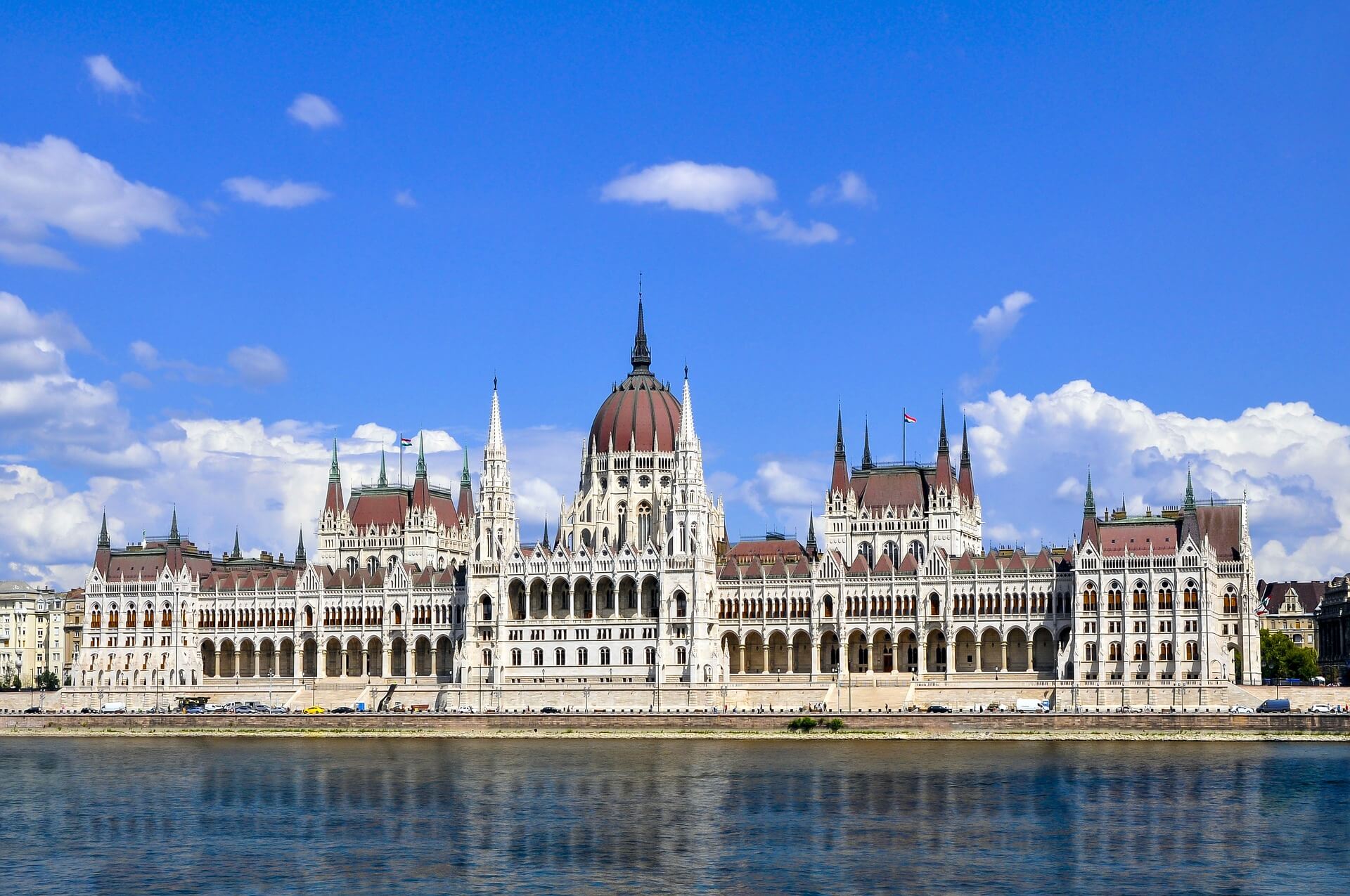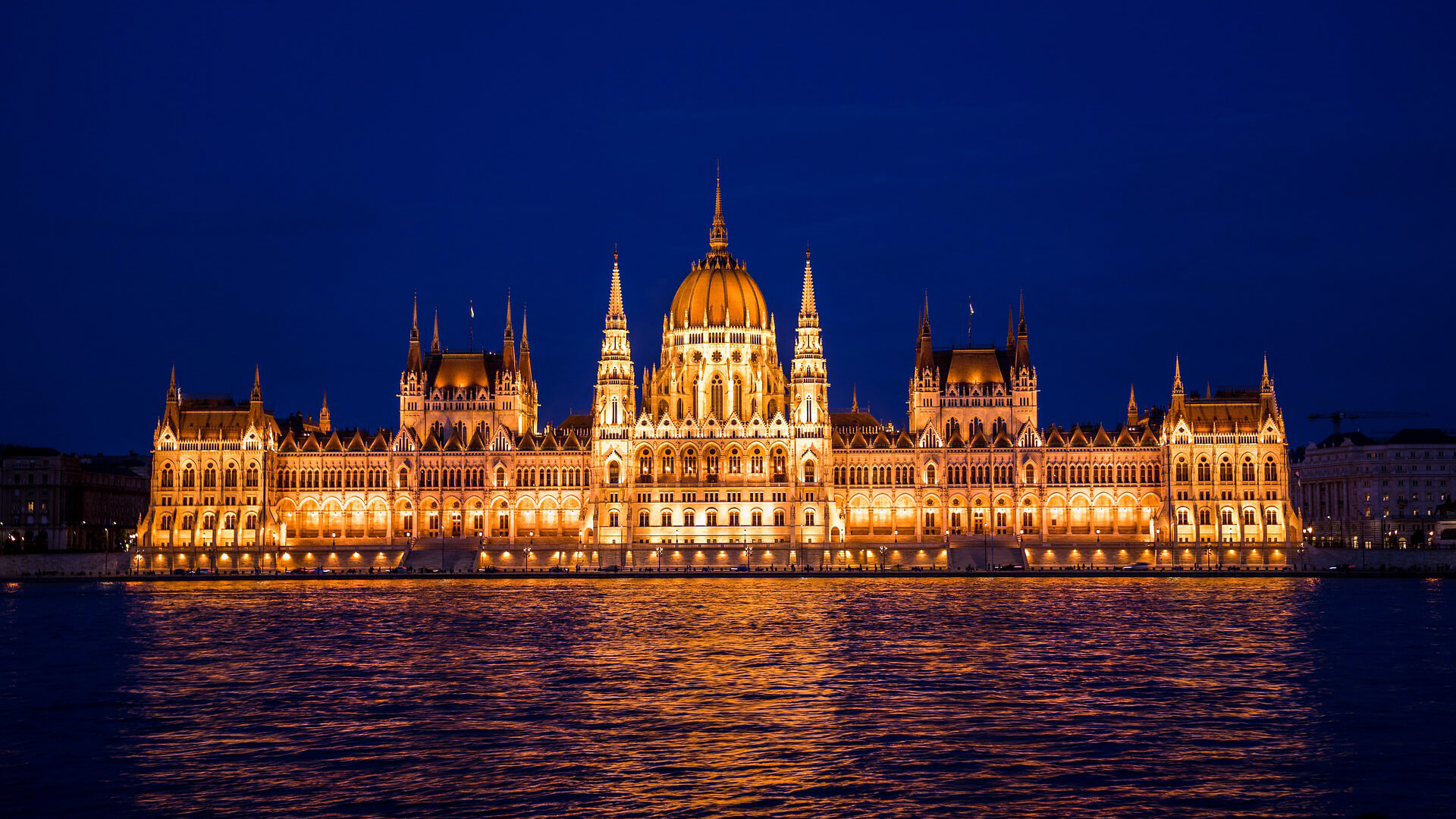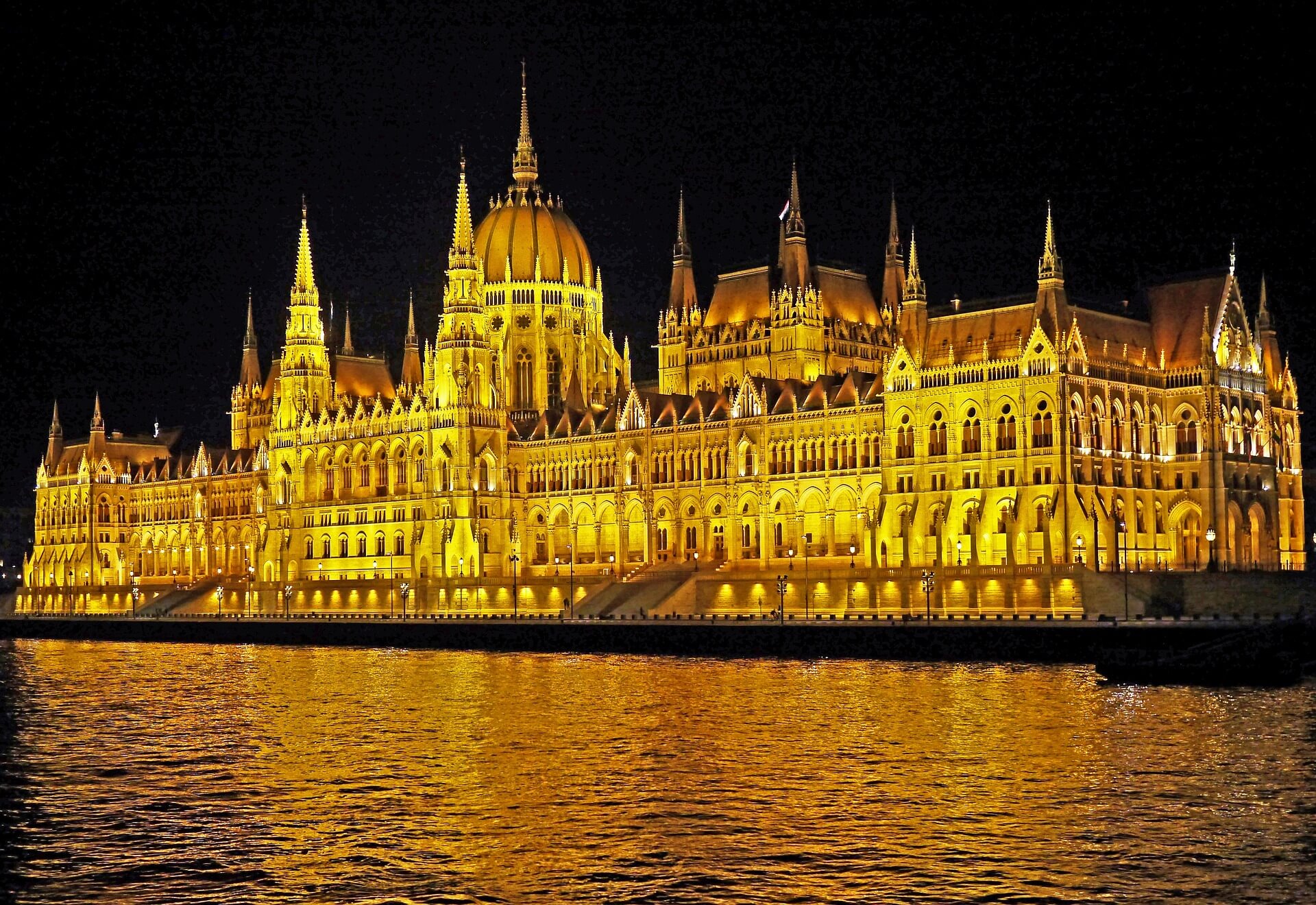Hungarian Parliament Building
Tours & Tickets
Ticket prices vary based on the tour language and the visitor’s status (adult, student, EU citizen, non-EU citizen, etc.). Discounts are often available for students and for citizens of the European Union.
The tour, which typically lasts about 45-50 minutes, generally includes visiting the Session Room, the Great Vaulted Hall, and the central staircase, as well as viewing the Holy Crown of Hungary.
Featured Tours
| Architectural style | Gothic Revival, Baroque, Renaissance |
|---|---|
| Location | Budapest, Hungary |
| Address | Budapest, Kossuth Lajos tér 1-3, 1055 Hungary |
| Coordinates | Latitude: 47°30′25″N, Longitude: 19°02′44″E |
| Construction start | 1885 |
| Completed | 1904 |
| Height | 96 m (315 ft) |
| Dimensions | Width: 123 m (404 ft) Length: 268 m (879 ft) |
| Floor count | 4 |
| Floor area | 18,000 m 2 (193,800 sq ft) |
| Lifts/elevators | 13 |
| Number of rooms | 691 |
| Website | www.latogatokozpont.parlament.hu |

A Historical Marvel
The construction of the Hungarian Parliament Building began in 1885 and was completed in 1902, taking a total of 17 years to finish. Designed by the renowned Hungarian architect Imre Steindl, the building’s construction was a testament to the skill and craftsmanship of Hungarian artisans. Steindl drew inspiration from various architectural styles, including Gothic, Baroque, and Renaissance, resulting in a unique blend of influences that make the Parliament Building truly one-of-a-kind.
Despite the untimely death of Imre Steindl, his vision was brought to life, and the Hungarian Parliament Building was inaugurated in 1904. Since then, it has stood as a symbol of Hungary’s independence and sovereignty, serving as the seat of power for the country’s National Assembly.
A Marvelous Feat of Construction
The Hungarian Parliament Building is not only renowned for its architectural beauty but also for the impressive scale of its construction. To bring Steindl’s vision to life, over 100,000 workers labored for 17 years, using approximately 40 million bricks. The building itself covers an impressive 18,000 square meters and features 691 rooms, making it one of the largest parliament buildings in the world.
The construction of the Parliament Building was a testament to Hungary’s commitment to showcasing its national identity and heritage. Hungarian raw materials were used extensively in the building’s construction, and only Hungarian craftsmen and manufacturers were involved in the project. This dedication to authenticity is evident in the building’s design, with the exception of the imported granite columns that adorn the main staircase.
A Marvelous Fusion of Architectural Styles
The Hungarian Parliament Building is a marvel of architectural fusion, combining elements of Gothic, Baroque, and Renaissance styles. Its exterior is characterized by intricate details, towering spires, and magnificent sculptures. The facade draws on the grandeur of Gothic architecture, with pointed arches, decorative tracery, and ornate carvings that adorn the walls. The Baroque influences can be seen in the building’s symmetrical layout and the elaborate decorations that grace its interior.
Inside the Parliament Building, visitors are greeted with a breathtaking display of opulence and grandeur. The main entrance, with its elegant staircase, is reminiscent of a royal palace, adorned with marble, lamps, sculptures, and gilded accents. The first-floor corridor, covered by a red carpet that stretches for nearly 3 kilometers, leads visitors to the heart of the building.
The Crown Jewels and Historic Chambers
One of the highlights of a visit to the Hungarian Parliament Building is the chance to see the ancient Hungarian crown jewels, including the Crown of St. Stephen. Housed in a room beneath the great cupola, these historic artifacts symbolize the country’s rich royal heritage and are a testament to its enduring sovereignty. The crown, along with the scepter, the orb, and the sword, is a sight to behold and stands as a reminder of Hungary’s storied past.
The Parliament Building also houses two historic chambers: the Lower House and the Upper Chamber. The Lower House, equivalent to the British House of Commons, is still in use today and is closed to the public. However, the Upper Chamber, with its stunning architecture and intricate details, is open for guided tours. Visitors can marvel at the symmetrical layout of the chambers, symbolizing the equal rights and importance of both houses in the Hungarian National Assembly.
Fascinating Facts and Figures
The Hungarian Parliament Building is filled with fascinating facts and figures that highlight its grandeur and significance. The building is adorned with approximately 90 stone statues on its facade, depicting important figures from Hungarian history. Inside, visitors can explore the 162 figures that grace the interior, each telling a story and contributing to the building’s historic ambiance.
The attention to detail is evident in the Parliament Building’s design. The cupola, reaching a height of 96 meters, symbolizes the unity of the legislature, while the 365 towers scattered throughout the building represent each day of the year. With 27 gates providing entry to the building and 29 staircases connecting its various levels, the Hungarian Parliament Building is a marvel of architectural planning and execution.
- Construction: The building’s construction began in 1885 and was completed in 1904.
- Architect: The Parliament Building was designed by Hungarian architect Imre Steindl, who went blind before its completion.
- Design: The design is in the Gothic Revival style and features a symmetrical façade and a central dome. The building has a length of 268 meters (879 feet) and a width of 123 meters (403 feet).
- Height: The central dome reaches a height of 96 meters (315 feet), which makes the Parliament Building one of the tallest structures in Budapest.
- Interior Size: Inside, there are more than 20 kilometers (12.5 miles) of stairs and enough space to house more than 691 rooms.
- Materials: Over 40 million bricks, half a million precious stones, and 40 kilograms of gold were used in the construction of the building.
- Crown Jewels: The Hungarian Parliament Building is home to the Holy Crown of Hungary, also known as the Crown of Saint Stephen, which is displayed in the central hall under high security.
- World Standing: With a floor area of 18,000 square meters (193,750 square feet), it’s one of the largest parliamentary buildings in the world.
- Maintenance: More than 1000 doors and windows are cleaned every day to keep the building looking its best.
- Symbolism: The height of the building (96 meters) holds great significance in Hungary, as it represents the year 896, which is when the Hungarian state was established.
- Competition for Design: Imre Steindl won the opportunity to design the building in a competition. The designs of the second and third place architects were also realized, facing the Parliament Building. They now house the Museum of Ethnography and the Ministry of Agriculture.
- Statues and Art: The building is adorned with 90 statues on its exterior, representing various Hungarian rulers, princes and military figures. The interior is equally ornate, with numerous frescoes, stained glass windows, and sculptures.
- Parliamentary Function: The building serves as the meeting place for the National Assembly of Hungary, which is unicameral (one chamber only). It was designed for a bicameral parliament and at the time of its construction was the largest parliamentary building in the world.
- Symbolic Number: There are 365 towers on the building, corresponding to the number of days in a year.
- World War II Damage: The building sustained considerable damage during World War II. Renovations took place in the decades following the war, and a major restoration project was completed in 2014.
- Visitors: The Parliament Building is one of the most visited tourist sites in Budapest. Inside, you can find the old House of Lords and the Hungarian Crown Jewels.
- Lamps: There are about 242 hand-painted, decorated lamps in the Parliament.
- Banks of the Danube: The Hungarian Parliament Building, along with the Banks of the Danube, the Buda Castle Quarter and Andrássy Avenue, is part of the UNESCO World Heritage Site in Budapest.
- Public Square: In front of the Parliament Building is Kossuth Lajos Square, a public space that has been a site for many political demonstrations and gatherings in Hungary’s history.
- Façade Material: The façade of the building is made of a type of limestone from the Gellért Hill, which unfortunately is rather sensitive to weather conditions, hence the frequent restorations.
- Largest Building in Hungary: The Parliament Building is the largest building in Hungary, and it was the largest parliament building in the world at the time of its completion.
- Imre Steindl’s Inspiration: Architect Imre Steindl was reportedly inspired by the Houses of Parliament in London. His design similarly showcases a neo-Gothic style and is situated on the bank of a major river.
- Facing the River: Unlike many parliament buildings that face the nation’s capital city, the Hungarian Parliament Building faces the Danube River. This decision was made to showcase its architectural beauty to those viewing from the river.
- Central Hall: The building’s central hall is adorned with brilliantly colored stained glass. This hall is also where the Hungarian Crown Jewels are displayed.
- Entrance Gates: There are 27 beautifully designed entrance gates leading into the building.
- Lions: Two lion statues guard the entrance of the Parliament Building, another nod to the Houses of Parliament in London.
- Ventilation System: The building was one of the first in Europe to have a built-in ventilation system.
- Stone Carvings: The Parliament Building’s exterior includes intricate stone carvings, which often require extensive restoration due to the elements.
Hungarian Parliament Building at Night
The Hungarian Parliament Building is a remarkable sight at night. Its stunning Gothic Revival architecture is illuminated against the night sky, making it one of the most striking landmarks in Budapest.
The building, which sits right on the bank of the Danube River, is beautifully mirrored in the water when lit up, providing an unforgettable spectacle. It’s a must-see for any visitor to Budapest, whether viewed from a river cruise, from the Buda side of the city, or from one of the many bridges spanning the river.
Moreover, the illumination of the building at night emphasizes the intricate details of the architecture, from the many statues and sculptures to the towering central dome. This spectacular sight is a testament to the architectural prowess of the building’s designer, Imre Steindl.
For photographers, the Hungarian Parliament Building at night is a favorite subject, and for good reason. The building is not only a symbol of Hungary’s legislative power but also an iconic symbol of Budapest itself. Whether you’re a local or a visitor, the view of the Parliament Building illuminated at night is a sight that never loses its allure.
Hungarian Parliament Night Photos
The best places to take stunning photos of the Hungarian Parliament
Taking a stunning photo of the Hungarian Parliament Building involves finding a location that offers a great view, preferably where the entire structure is in sight, and where lighting conditions are favorable. Here are a few recommended spots:
1. Across the Danube on the Buda side: The best spot for a classic shot of the Parliament Building is from the Buda side of the Danube River, particularly from the area around Batthyány Square (Batthyány tér). This location offers an unobstructed view of the full facade of the Parliament. It’s beautiful at any time of day, but especially striking at dusk or at night when the building is beautifully lit up.
2. From the Fisherman’s Bastion: Located in the Buda Castle district, the Fisherman’s Bastion offers a panoramic view of the Pest side of the city and the Danube, including the Parliament Building. This location is excellent for a wider shot that captures the Parliament Building along with the river and other parts of the city. The early morning and late evening provide the best light for photos here.
3. From a Boat on the Danube: Taking a river cruise on the Danube can also offer some great photo opportunities. From the river, you get a close-up view of the Parliament Building, and the motion of the boat can also give your photos a unique perspective. Night cruises are particularly beautiful as the building is spectacularly illuminated.
4. From the Chain Bridge: The Chain Bridge offers a close and slightly elevated view of the Parliament Building, particularly beautiful at sunrise or sunset. However, please be careful when taking pictures, as it’s a busy bridge with both pedestrian and vehicle traffic.
5. From Margaret Island: Margaret Island sits in the middle of the Danube and offers a more distant but unique perspective of the Parliament Building, particularly from the water tower.
6. From the top of the St. Stephen’s Basilica: This location offers a panoramic view of Budapest’s cityscape, including the Parliament Building. You can use the height to your advantage and capture an image that includes other elements of the city.
Remember, much depends on the weather, lighting, and time of day, so patience is key when trying to capture that perfect shot.
Exploring the Hungarian Parliament Building
Visiting the Hungarian Parliament Building is an unforgettable experience that allows visitors to immerse themselves in Hungary’s rich history and architectural heritage. Guided tours are available in multiple languages, including English, providing visitors with a deeper understanding of the building’s significance and the stories it holds within its walls.
It is advisable to purchase tickets in advance, either online or at the ticket offices, to avoid long queues. The Parliament Building has specific opening hours, and it is recommended to check the schedules beforehand to plan your visit accordingly. Please note that certain national holidays and festival days may affect the building’s availability for tours.
Nearby Dining Options
After exploring the Hungarian Parliament Building, take the opportunity to indulge in the culinary delights of Budapest. There are several excellent dining options in the vicinity that offer traditional Hungarian cuisine and international favorites. Here are a few recommendations:
-
Hungarikum Bisztro: This informal eatery offers authentic Hungarian dishes such as goulash, duck confit, and meat stews. It is a great place to savor the flavors of Hungary in a relaxed and casual setting.
-
Tulipano: For a more upscale dining experience, Tulipano serves gastronomic Hungarian dishes at reasonable prices. From pork loin to venison stew, their menu offers a variety of meat dishes that showcase the richness of Hungarian cuisine.
-
Madal Cafe: If you’re looking for a quick bite or a cup of coffee, Madal Cafe is conveniently located near the Parliament Building. They offer a selection of coffees, rolls, and simple dishes to recharge before continuing your exploration of Budapest.
Where to Stay in Budapest
Budapest offers a wide range of accommodations to suit every traveler’s needs. If you’re looking for quality, comfort, and a central location, consider staying at the Barcelo Budapest. This four-star hotel is situated in the heart of Budapest’s historic quarter, just a short walk from iconic attractions such as the Opera and St. Stephen’s Basilica. With modern amenities and excellent service, the Barcelo Budapest provides the perfect base for exploring the city.
FAQs
Where is the Hungarian Parliament Building located?
The Hungarian Parliament Building is located on the bank of the Danube River in Budapest, Hungary.
When was the Hungarian Parliament Building built?
The construction of the Hungarian Parliament Building started in 1885 and it was completed in 1904.
Who designed the Hungarian Parliament Building?
The Hungarian Parliament Building was designed by Imre Steindl, a Hungarian architect.
What architectural style is the Hungarian Parliament Building?
The Hungarian Parliament Building is built in the Gothic Revival style, with a symmetrical facade and a central dome. It also has elements of Renaissance and Baroque architecture.
How many rooms does the Hungarian Parliament Building have?
The Hungarian Parliament Building has 691 rooms, 10 courtyards, 13 elevators, 27 gates, 29 staircases, and 365 towers.
What is the size of the Hungarian Parliament Building?
The Hungarian Parliament Building is approximately 268 meters long, 123 meters wide and its dome is 96 meters high, making it one of the largest parliamentary buildings in the world.
Can you visit the Hungarian Parliament Building?
Yes, the Hungarian Parliament Building is open to the public for guided tours when the National Assembly is not in session. It's recommended to book tickets in advance due to high demand.
What can you see inside the Hungarian Parliament Building?
Inside the Parliament Building, you can see the old House of Lords and the Hungarian Crown Jewels, which include the Holy Crown of Hungary.




